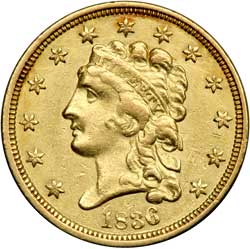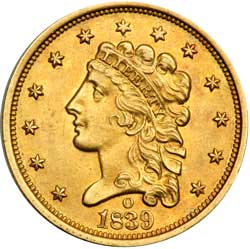
|
Sale 78
January Pre-Long Beach Sale 17.5% BP
| Lot |
Photo |
Description |
Realized |
Lot 1694 |
 |
1836. Script 8 NGC graded AU Details. Improperly cleaned. Significant mint luster remains about the protected areas (PCGS # 7694) .
Estimated Value $600 - 700.
Ex: Purchased from Abner Kreisberg in the 1970's The Del Valle Collection.
View details and enlarged photos
Check results on similar lots
| Realized
$676 |
Lot 1695 |
 |
1837 PCGS graded Genuine VF Details. Filed Rims. Mostly untoned. Only 45,080 minted (PCGS # 7695) .
Estimated Value $350 - 400.
View details and enlarged photos
Check results on similar lots
| Realized
$423 |
Lot 1696 |
 |
1839-O. PCGS graded AU-58. Well struck with plenty of frosty mint luster. Attractive natural golden-orange overtones add to its appeal. The first Quarter Eagle issue at the New Orleans Mint, the 1839-O is also the only O-mint delivery of the Classic Head type (to include also the Classic Half Eagle). It is a scarce issue in an absolute sense with Doug Winter (2006) accounting for only 350 to 400 survivors out of a mintage of 17,781 pieces. Higher quality pieces such as this are conditionally scarce and seldom offered in numismatic sales. Pop 29; 21 finer (PCGS # 7701) .
An account of the New Orleans Mint: The New Orleans Mint was authorized by President Andrew Jackson in 1835 along with two other smaller Southern mints in North Carolina and Georgia. All three Southern mints struck coins until the War Between the States began.
Coinage was always in short supply early in our country�s history. The dollar value of silver as defined in the coinage act 1792 was based on the weight of silver in the Spanish milled dollar. The Spanish Dollar was cut into 1/8th pieces or bits for small change. Even today a quarter is sometimes referred to as two bits. The Mint was supposed to put more honest coinage into circulation with less dependence on paper money issued by the banks. As late as 1857 foreign coinage was freely circulated in the US along side of US coins because of the shortage of US coins. Until that time the US congress issued various acts authorizing the legal value of foreign coins. In 1857 congress repealed all acts granting legal tender status to any and all foreign coins.
The New Orleans Mint not only had an interesting beginning but an interesting life as well. Construction was completed on the New Orleans facility and minting was started in 1838 where silver denominations were struck initially. Gold followed in 1839. The New Orleans Mint was operated as a branch mint under the Philadelphia mint. Several apartments were located in the mint building where the superintendent and other officers of the mint resided. When Louisiana seceded in January 1861 the State of Louisiana declared itself an independent sovereign nation and seized the federal forts, lighthouses, customhouses and the Mint. A few months later in March the State of Louisiana accepted the constitution of the Confederate States of America. At that point the State of Louisiana signed over use of all the forts, lighthouses, customhouses and the Mint to the newly formed CSA government.
The CSA government sent an envoy to Washington DC to meet with President Lincoln to pay fair value for the federal property that was now located in the CSA and to negotiate to pay their fair share of the national debt but Lincoln refused to see the delegation.
The CSA resumed operations and minted coins for a short while during the month of April 1861, but quickly ran out of bullion by the end of the month. (Records show that approximately $6,000,000 in bullion was confiscated from the New Orleans mint and custom house.)
Operations then ceased and the building was used to house CSA troops. After Admiral Farragut took New Orleans the mint fell into Northern hands. An unfortunate incident took place at the mint just after Farragut's marines took New Orleans and hoisted the US flag at the mint. A local named Mumford along with a few Southern patriots took down the US flag and tore it to pieces. General Butler had Mr. Mumford hanged at the Mint which caused President Jefferson Davis to issue an order to hang "spoons" Butler on sight when and if possible. Prior to the evacuation of the city the Southern troops transferred much of the equipment to foundries throughout the South. The building was then used to house Northern occupation troops under the command of the hated General Butler. After the war the Mint building was maintained by the US government and fell into further disuse and neglect.
Estimated Value $5,000 - 6,000.
Ex: Purchased from Superior Galleries in the 1970's The Del Valle Collection.
View details and enlarged photos
Check results on similar lots
| Realized
$10,281 |
|
|